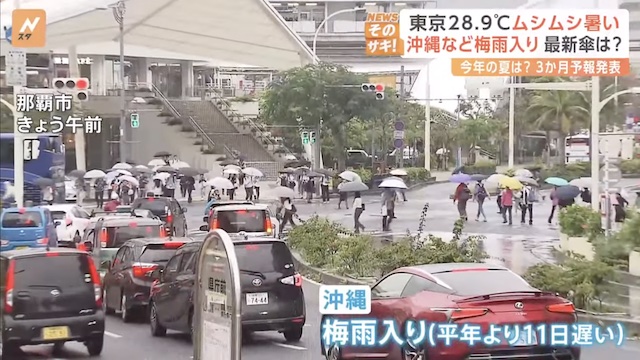NAHA, May 21 (News On Japan) - With Okinawa and Amami entering the rainy season 11 days later than usual, the question is: What does the weather forecast for Japan's summer hold?

On May 21, Tokyo experienced its hottest day of the year with temperatures reaching 28.9°C, comparable to early July, resulting in a humid day. Due to the influence of the seasonal rain front, Miyakojima City recorded the heaviest rainfall ever observed, with 100 millimeters of rain in one hour, causing flooding in some areas.
Inoue Takahiro, anchor: 'We need to brace for the summer heat. Even in late May, temperatures across the country have exceeded 30 degrees. On the 21st, temperatures especially rose on the Pacific side.'
Hirose Shun, weather forecaster: 'On the 21st, the Japan Meteorological Agency announced that Okinawa and Amami have likely entered the rainy season.'
Although these announcements are sometimes revised in September, the definition of the rainy season is based on an increase in cloudy or rainy days compared to adjacent periods. Therefore, the exact position of the rain front is not strictly included in the definition, and forecasts may change with subsequent corrections.
Inoue, anchor: 'The rainy season in Okinawa and Amami is 11 days later than usual. In Miyakojima City, it rained 100 millimeters per hour early on the 21st, setting a record.'
Looking at the weekly forecast for Tokyo, the weather is expected to become unsettled around May 27th. This may signal the beginning of the rainy season.
Hirose: 'This is likely to be the "pre-rainy season." Before the main rainy season, there are periods of unsettled weather known as the "pre-rainy season." It is expected that the pre-rainy season will start around May 27th, with the official announcement of the rainy season likely in early June after a brief improvement in the weather.'
Inoue: 'From a layperson's perspective, it might seem appropriate to call it the rainy season when rain marks appear around the 27th, but professionals might have a different view.'
Former Japanese swimming representative Takeshi Matsuda: 'We should almost consider it the rainy season. Until recently, the sunlight was strong but the humidity was low, making it dry. Now, the humidity has suddenly increased.'
Inoue: 'The rainy season in Kanto-Koshin usually starts from early to mid-June. In recent years, it started around June 11 in 2020, June 14 in 2021, June 6 in 2022, and June 8 in 2023.'
Hirose: 'Typically, the rainy season in Kanto-Koshin starts around June 7. However, it was announced as early as May 27 in 2011. According to the forecast, there is a possibility that the rainy season will start after June this year.'
Japan Meteorological Agency's 3-Month Forecast: Concerns Over Heavy Rain This Year
Inoue: 'The newly released three-month precipitation forecast indicates:
- June: Precipitation is expected to be average or above average from Okinawa to the Pacific side of western Japan.
- July: Precipitation is expected to be average or above average from western Japan to the Pacific side of eastern Japan.
- August: Precipitation is expected to be average nationwide.
Hirose: 'Since April, the forecast has changed, indicating that areas likely to receive rain in July have expanded. This year's El Nino phenomenon contributes to moist air flowing into the rainy season, increasing the risk of heavy rain. Consequently, the likelihood of heavy rain has risen significantly. Typically, during unsettled weather, temperatures do not rise much. However, due to the record warm winter, the sea has warmed like a hot water bottle, making it likely that temperatures will remain high regardless of the weather. Therefore, there is also concern about extreme heat following the rainy season.'
Inoue: 'The warmed sea, full of steam, can particularly affect Kyushu if there is a typhoon. However, this year, it is expected to impact a wider area. What kind of rainy season can we expect this year?'
'Last year, there was little rain in the Kanto region during the rainy season, but this year, there are greater concerns about heavy rain, including the possibility of linear precipitation bands causing heavy rainfall.'
Hirose: 'Most of the torrential rains during the rainy season are caused by linear precipitation bands. When moist air flows in, there is concern about the occurrence of linear precipitation bands. Therefore, I hope everyone will be especially vigilant about rain information this year.'
Chiaki Horan, anchor: 'Every year, heavy rain during the rainy season often overlaps with linear precipitation bands, leading to water damage. This is concerning.'
Matsuda: 'I think it is necessary to prepare for water and landslide disasters now.'
Source: TBS















